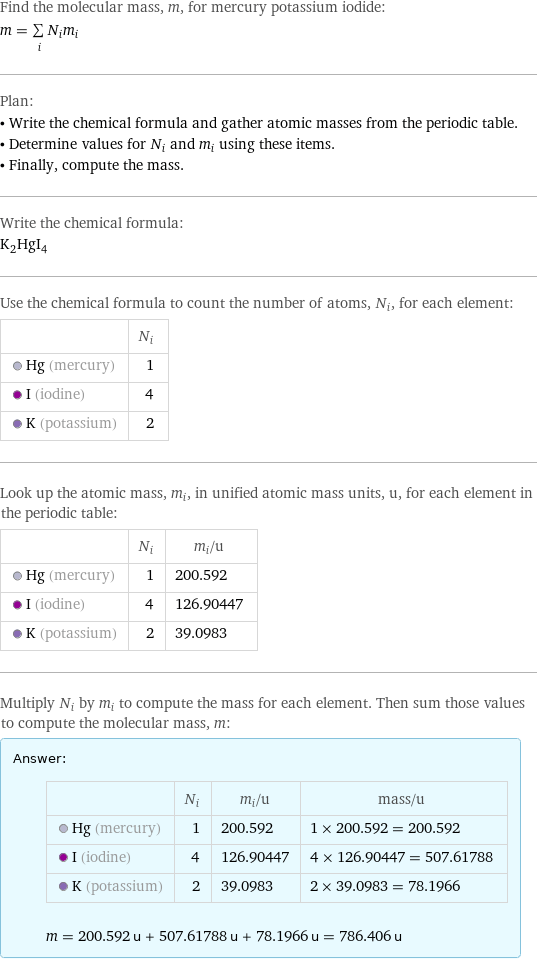Input interpretation

mercury potassium iodide | molecular mass
Result

Find the molecular mass, m, for mercury potassium iodide: m = sum _iN_im_i Plan: • Write the chemical formula and gather atomic masses from the periodic table. • Determine values for N_i and m_i using these items. • Finally, compute the mass. Write the chemical formula: K_2HgI_4 Use the chemical formula to count the number of atoms, N_i, for each element: | N_i Hg (mercury) | 1 I (iodine) | 4 K (potassium) | 2 Look up the atomic mass, m_i, in unified atomic mass units, u, for each element in the periodic table: | N_i | m_i/u Hg (mercury) | 1 | 200.592 I (iodine) | 4 | 126.90447 K (potassium) | 2 | 39.0983 Multiply N_i by m_i to compute the mass for each element. Then sum those values to compute the molecular mass, m: Answer: | | | N_i | m_i/u | mass/u Hg (mercury) | 1 | 200.592 | 1 × 200.592 = 200.592 I (iodine) | 4 | 126.90447 | 4 × 126.90447 = 507.61788 K (potassium) | 2 | 39.0983 | 2 × 39.0983 = 78.1966 m = 200.592 u + 507.61788 u + 78.1966 u = 786.406 u
Unit conversions

786.406 Da (daltons)

0.786406 kDa (kilodaltons)

1.30586×10^-21 grams

1.30586×10^-24 kg (kilograms)

786.44 chemical atomic mass units (unit officially deprecated)

786.656 physical atomic mass units (unit officially deprecated)
Comparisons as mass of molecule

≈ 1.1 × molecular mass of fullerene ( ≈ 721 u )

≈ 4 × molecular mass of caffeine ( ≈ 194 u )

≈ 13 × molecular mass of sodium chloride ( ≈ 58 u )
Corresponding quantities

Relative atomic mass A_r from A_r = m_aN_A/M_u: | 786

Molar mass M from M = m_aN_A: | 786 g/mol (grams per mole)

Relative molecular mass M_r from M_r = m_mN_A/M_u: | 786

Molar mass M from M = m_mN_A: | 786 g/mol (grams per mole)